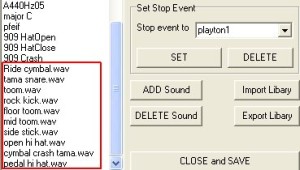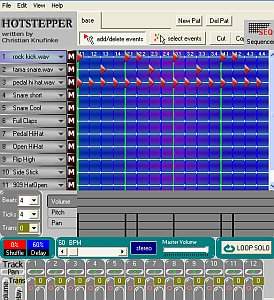Download drum pattern for Hotstepper Sequencer
If you do not have real drums, you can still create real sounding drum loops using Hotstepper drum sequencer for free. This tutorial will list down all the most common drum beats in rock, jazz, metal, punk and pop which can be created in Hotstepper. This is very useful and time-saving tutorial. It is because you can simply listen to the provided drum beat MP3 samples in this tutorial and download the hotstepper file. I created all these patterns from my experience and recorded the sample drum beat for listening.
As a requirement, make sure you have hotstepper installed and you have imported the proper drum recordings to your library. If you have not done this step, read this tutorial. Follow the steps mentioned in that tutorial and ensure that the sound file specifications are correct. Please use the following file names for the drum parts for consistency with the provided pattern:
rock kick.wav
tama snare.wav
pedal hi hat.wav
open hi hat.wav
mid toom.wav
floor toom.wav
cymbal crash tama.wav
Ride cymbal.wav
Even though your drums might not be Tama (as the drum sounds above are obtained from a Tama drum kit), please use the same file name to avoid errors when you are using the downloaded Hotstepper file later on.
3.) Confirm if you have successfully added this drum sound parts to the Hotstepper sound library. Launch Hotstepper and then go to View – Sound Library. See screenshot below. The important drum sound parts are in .wav extension.

4.) Select from the following most common drum beats that you need to use in your multi-track recording projects. Listen to the mp3 sample provided and then click the link of the pattern to download the .hpa file. Take note that you can further improve it such as increasing or decreasing the tempo, adding some more takes using Hotstepper.
———————–PATTERN1—————————–
Comment: This one of the most common drum beat pattern in pop music.
Download pattern1
———————–PATTERN2—————————–
Comment: This is a fast punk alternative drum pattern. Increasing further the tempo (adjusting it in the Hotstepper) would be similar to the “Policia” by Sepultura
———————–PATTERN3—————————–
Comment: An example of a tribal drum beat achieved using toms and double bass.
Download pattern3
———————–PATTERN4—————————–
Comment: This is another common drum beat variation found in pop and alternative music.
Download pattern4
———————–PATTERN5—————————–
Comment: This is a heavy metal drum beat pattern that is fast using double bass.
Download pattern5
———————–PATTERN6—————————–
Comment: Slow 12-bar blues drum beat.
Download pattern6
———————–PATTERN7—————————–
Comment: Punk drum beat 1. Very simple kick and snare combination.
Download pattern7
———————–PATTERN8—————————–
Comment: Punk drum beat 2. Fast kick and snare.
Download pattern8
———————–PATTERN9—————————–
Comment: Punk drum beat 3. Kick –tom and floor tom combination.
Download pattern9
———————–PATTERN10—————————–
Comment: Punk drum beat 4. Fast double pedal on the kick and snare combination.
Download pattern10
———————–PATTERN11—————————–
Comment: Jazz drum beat pattern.
After downloading the pattern, right click on the zip file and then click “Extract here”. The .hpa file will then be extracted. After that, launch Hotstepper (now with the newly added drum parts in its library) and go to File – Open and if you see the warning “Do you want to save before continuing?” just click “No”. Then in the “Open” dialog box, select the .hpa file (e.g. pattern1.hpa); then click Open. It will look like below after opening the pattern:

When you play the loop it should sound like the mp3 sample provided above. You can edit it if you want. IMPORTANT: Every time you quit this software by closing it, it will always ask: Do you want to save before continuing? The rule is that if you are not editing the pattern, simply click no. Clicking yes will save the changes made.
Content last updated on October 10, 2012









9 Responses
@Rebecca, please look at the above tutorial section (converting HPA to 32-bit float/96KHz wav).
Hi Rebecca, thanks for dropping by. I will write a tutorial on this. To get the latest updates, you can subscribe to this blog so you will get immediately notified when a new tutorial gets published.
Hi ! I would also like to know how you convert a hpa file to wav file.. Look all over google, but I coludn’t find a single thing about it…
Hi Robert,
You could spend one hour in the studio recording real drum sounds, in this case, you will go to the studio to record crash, ride cymbals, etc. But you do not need to worry since, you will only do this ONCE. After you have recorded it in the studio, you can then incorporate it using the sequencer. You can reuse the recorded wav in your own projects using the sequencer without any limit. However, if you fill a certain project needs a different sound, then you have go to the studio again and record the sound your want. But this will not usually happen , unless you are mixing and producing a lot of genres.
hey, i was just wondering where i could get some of those sample .wav files like the crash and ride cymbals. considering i don’t have a drum kit to record them off of
Hi Anonymous,
Great comment! I will make a tutorial for this one, please come back to this blog, I will write this one within this month.
Cheers.
I created a Hotstepper drum sequence utilizing the available sounds provided by Hotstepper. I can’t figure out how to convert those sounds from .hpa files to wav files. Can you help me?
Thanks for reading my blog mate! I am glad you now found a solution to create drum tracks without any hassle.
Cheers,
Emerson
nice s/ware u got there mate! thx. i can now produce my own song w/out a drummer and of course suits my taste!
brilliant!